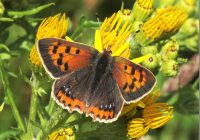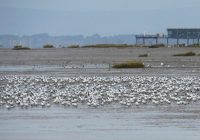Dr Phil Smith’s Wildlife Notes
October 2016
October is traditionally the wettest month of the year but this one was the driest in living memory with measurable rainfall on only three days. It was also milder than usual with no frost. This was caused by persistent high pressure over Scandinavia, a pattern that in the recent past has often switched in winter to low pressure with westerly winds and high rainfall, as in 2015/16. We shall see.
Easterly winds, especially early in the month, led to an unprecedented arrival of Yellow-browed Warblers from Siberia on the east coast, record numbers also reaching our side of the country. Remarkably, four were trapped by ringers at Rimrose Valley on 9th, with another there on 13th. Others were reported at Crosby Coastal Park, Hightown dunes, Ainsdale Sandhills Local Nature Reserve, Ainsdale National Nature Reserve, Marshside and Martin Mere. Regrettably, none came my way! Another amazing bird sighting was of a flock of nine Great White Egrets flying north at Ainsdale-on-Sea on 5th. Three of the smaller but equally uncommon Cattle Egrets spent the month at Marshside, following cows in the approved manner on the RSPB reserve. I did manage to catch up with these.
The relatively mild weather meant that some butterflies and other insects were active late into the month. My favourite patches of flowering ivy in the Ravenmeols woodland were graced by as many as 20 Red Admirals on 6th, two of these stunning insects remaining until 24th. A Painted Lady was also on the ivy, while others turned up at Birkdale Green Beach and Falklands Way Ainsdale, their fresh condition indicating these had been reared locally from earlier migrants. Small Coppers also had a late brood, with small numbers in several places on the dunes. The occasional Common Darter was not exceptional for October, while Field Grasshoppers were still to be found throughout the month on south-facing slopes.
A visit to Marshside saltmarsh on 11th with Patricia Lockwood and student botanist Joshua Styles was rewarded with the usual four species of Glasswort, now showing attractive autumn tints. Searching the strandline at the back of the marsh, we also found Babington’s Orache and the two scarce hybrids, Kattegat and Taschereau’s Orache, as well as a single specimen of the rare Long-stalked Orache. Other noteworthy plants on the adjacent coast-road embankment were Sea Campion, Viper’s Bugloss and Early Goldenrod, while Josh was also keen to see the Golden Dock I spotted last month in front of Nel’s Hide on the RSPB reserve.
A later trip with Pat and Josh to Falklands Way produced a huge Yucca in full flower and ten out of the 19 different Cotoneasters recorded for the Sefton Coast. These garden-escapes can be challenging to identify but, although they turn up regularly on the dunes from berries dispersed by birds, they don’t become invasive here. I also collected material from a non-native variegated Wormwood to send to a specialist in Belgium who will investigate its relationship to other species using molecular analysis. We found the plant in 2010 but haven’t been able to name it yet.
Several visits to the Devil’s Hole in the Ravenmeols Local Nature Reserve revealed that the depleted water-table was about 20cm below the ground surface. Many plants there were still flowering late into the month, including Common Milkwort which is usually only seen in June/July. A photo of a moss that I didn’t recognise was identified by Des Callaghan as Woody Thyme-moss (Plagiomnium cuspidatum), a species that is fairly widespread in northern and western Britain but scarce in South Lancashire. I was also pleased to find two adult Smooth Newts, while nine Mistle Thrushes took off with their characteristic rattling call. Unfortunately this wonderful place was heavily scarred by quad-bike tracks. It reminded me of an incident many years ago when I confronted a rough-rider on the dunes at Birkdale. He justified his activities by describing this internationally ranked nature reserve as “scrap land”.
Following up a report by John Dempsey, Pat Lockwood and I searched the slacks at Ainsdale LNR on 25th. We counted over 250 Field Gentians, including many still in full flower. This beautiful plant is Red Data Book listed as “Endangered” in England, our dunes probably supporting the largest population in the country. Later we called in at the Tesco carpark in Southport where Brian Woolley had reported Broad-leaved Helleborines. Sure enough, we found eight spikes of this uncommon orchid under a Beech hedge on the edge of the carpark.
Finally, the regular series of “Buckthorn Bashes” began with volunteers clearing invasive Sea Buckthorn at Ainsdale. Our fame is spreading, as Garry Hibberd, the manager of Norfolk Wildlife Trust’s Holme reserve got in touch to ask how many annual cuts were required to control this menace. The answer is at least five, so you have to keep at it.




